The explosive vigour of the universe is thus matched with almost unbelievable accuracy to its gravitating power. The big bang was not evidently, any old bang, but an explosion of exquisitely arranged magnitude. Paul Davies, Professor of Theoretical Physics 17
In the first chapter we examined the universe's Creation from nothingness as a result of a great explosion. Let us now consider some of the implications of this.
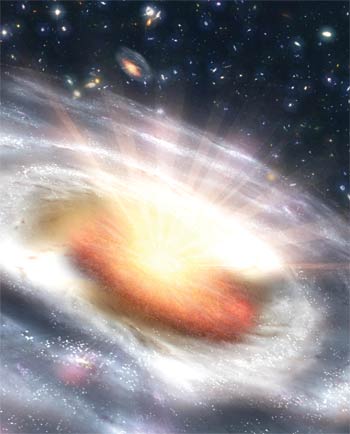 |
Scientists estimate that there are over 300 billion galaxies in the whole universe. These galaxies have a number of different forms (spiral, elliptical, etc) and each contains about as many stars as the universe contains galaxies. One of these stars, the Sun, has nine major planets rotating around in it in great harmony. All of us live on the third of those planets counting from the Sun.
Look about you: Does what you see appear to be a disordered jumble of matter haphazardly scattered this way and that? Of course not. But how could matter have formed organized galaxies if it had been dispersed randomly? Why has matter accumulated at certain points and formed stars? How could the delicate balance of our solar system have emerged from a violent explosion? These are very important questions and they lead us to the real question of how the universe was structured after the Big Bang.
If the Big Bang was indeed a such cataclysmic explosion then it is reasonable to expect that matter should have been scattered everywhere at random. And yet it is not. Instead it is organized into planets, and stars, and galaxies, and clusters of galaxies, and superclusters of galaxies. It is as if a bomb that exploded in a granary caused all the wheat to fall into neat sacks and bales on the backs of trucks ready to be delivered instead of showering the grains every which way. Fred Hoyle, a staunch opponent of the Big Bang theory for years, expressed his own surprise at this structure:
The big bang theory holds that the universe began with a single explosion. Yet as can be seen below, an explosion merely throws matter apart, while the big bang has mysteriously produced the opposite effect–with matter clumping together in the form of galaxies.18
That the matter produced by the Big Bang should have formed such tidy and organized shapes is indeed an extraordinary thing. The occurrence of such a harmony leads us to the realization that the universe was the result of its perfect Creation by Allah.
In this chapter we will examine and consider this extraordinary perfection and excellence.
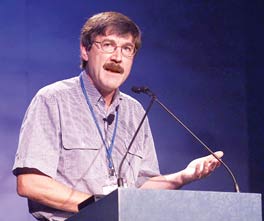 |
| Paul Davies: "The evidence is strong enough to acknowledge the existence of a conscious cosmic design." |
People hearing of the Big Bang but not considering the subject at length do not think about what an extraordinary plan must lie behind this explosion. That's because the notion of an explosion doesn't suggest harmony, plan, or organization to most people. In fact there are a number of very puzzling aspects to the intricate order in the Big Bang.
One of these puzzles has to do with the acceleration caused by the explosion. When the explosion took place, matter certainly must have begun moving at an enormous speed in every direction. But there is another point that we need to pay attention to here. There must also have been a very big attractive force at the first moment of the explosion: an attractive force that was strong enough to gather the whole universe into one point.
Two different and opposing forces are at work here. The force of the explosion, driving matter outward and away, and the force of attraction, trying to resist the first and pull everything back together. The universe came into being because these two forces were in equilibrium. If the attractive force had been greater than the explosive, the universe would have collapsed. If the opposite had been true, matter would have been splattered in every direction in a way never to unite again.
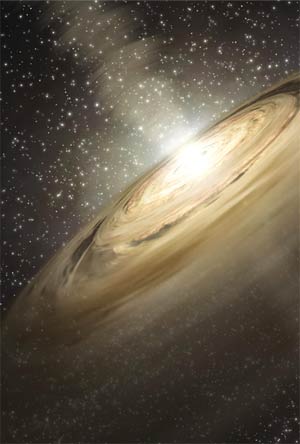 |
| It is We Who have built the universe with (Our creative) power, and, verily, it is We Who are steadily expanding it. |
Then how sensitive was this equilibrium? How much "slack" could there have been between the two forces?
The mathematical physicist Paul Davies, a professor at the University of Adelaide in Australia, performed lengthy calculations of the conditions that must have existed at the moment of the Big Bang and came up with a result that can only be described as astonishing. According to Davies, if the rate of expansion had differed by more than 10-18 seconds (one quintillionth of a second), there would have been no universe. Davies describes his conclusion:
Careful measurements puts the rate of expansion very close to a critical value at which the universe will just escape its own gravity and expand forever. A little slower and the cosmos would collapse, a little faster and the cosmic material would have long ago completely dispersed. It is interesting to ask precisely how delicately the rate of expansion has been "fine tuned" to fall on this narrow dividing line between two catastrophes. If at time I S (by which the time pattern of expansion was already firmly established) the expansion rate had differed from its actual value by more than 10-18, it would have been sufficient to throw the delicate balance out. The explosive vigour of the universe is thus matched with almost unbelievable accuracy to its gravitating power. The big bang was not evidently, any old bang, but an explosion of exquisitely arranged magnitude.19
Bilim Teknik (Science Technique, a Turkish scientific periodical) quotes an article that appeared in Science in which the phenomenal equilibrium that obtained in the initial phase of universe is stated:
If the density of the universe was a little bit more, in that case, according to Einstein's relativity theory, the universe would not be expanding due to the attraction forces of atomic particles but contracting, ultimately diminishing to a spot. If the initial density had been a little bit less, then the universe would rapidly be expanding, but in this case, atomic particles would not be attracting each other and no stars and no galaxies would ever have formed. Consequently, man would never come into existence! According to the calculations, the difference between the initial real density of the universe and its critical density, which is unlikely to occur, is less than one percent's one quadrillion. This is similar to place a pencil in a position so that it can stand on its sharp end even after one billion years… Furthermore, as the universe expands, this equilibrium becomes more delicate.20
Even Stephen Hawking, who tries hard to explain away the Creation of the universe as a series coincidences in A Brief History of Time, acknowledges the extraordinary equilibrium in the rate of expansion:
If the rate of expansion one second after the big bang had been smaller by even one part in a hundred thousand million million, the universe would have recollapsed before it ever reached its present size.21
What then does such a remarkable equilibrium as this indicate? The only rational answer to that question is that it is proof of Creation and cannot possibly be accidental. Despite his own materialist bent, Dr Davies admits this himself:
It is hard to resist that the present structure of the universe, apparently so sensitive to minor alterations in the numbers, has been rather carefully thought out… The seemingly miraculous concurrence of numerical values that nature has assigned to her fundamental constants must remain the most compelling evidence for an element of cosmic design.22
The speed of the Big Bang's explosion is only one of the remarkable states of equilibrium at the initial moment of Creation. Immediately after the Big Bang, forces that underpin and organize the universe we live in had to be numerically "just right" otherwise there would have been no universe.
These are the "four fundamental forces" that are recognized by modern physics. All structure and motion in the un-iverse is governed by these four forces, known as the gravitational force, the electromagnetic force, the strong nuclear force, and the weak nuclear force. The strong and weak nuclear forces operate only at the atomic scale. The remaining two–the gravitational force and the electromagnetic force–govern assemblages of atoms, in other words "matter". These four fundamental forces were at work in the immediate aftermath of the Big Bang and resulted in the Creation of atoms and matter.
A comparison of those forces is enlightening for their values are stunningly different from one another. Below they are given in international standard units:
Strong nuclear force: 15
Weak nuclear force: 7.03 x 10-3
Electromagnetic force: 3.05 x 10-12
Gravitational force: 5.90 x 10-39
Notice how great are the differences in the strengths of these four fundamental forces. The difference between the strongest (strong nuclear force) and the weakest (gravitational force) is about 25 followed by 38 zeros! Why should this be so?
The molecular biologist Michael Denton addresses this question in his book, Nature's Destiny:
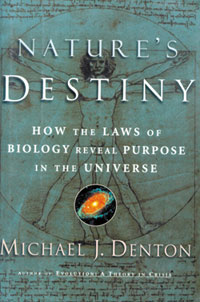 |
| The molecular biologist Michael Denton addresses an important point in his book, Nature's Destiny: How the Laws of Biology Reveal Purpose in the Universe. According to Denton, the universe was specially created to make human life possible. |
If, for example, the gravitational force was a trillion times stronger, then the universe would be far smaller and its life history far shorter. An average star would have a mass a trillion times less than the sun and a life span of about one year. On the other hand, if gravity had been less powerful, no stars or galaxies would have ever formed. The other relationships and values are no less critical. If the strong force had been just slightly weaker, the only element that would be stable would be hydrogen. No other atoms could exist. If it had been slightly stronger in relation to electromagnetism, then an atomic nucleus consisting of only two protons would be a stable feature of the universe–which would mean there would be no hydrogen, and if any stars or galaxies evolved, they would be very different from the way they are. Clearly, if these various forces and constants did not have precisely the values they do, there would be no stars, no supernovae, no planets, no atoms, no life.23
Paul Davies comments on how the laws of physics provide for conditions ideal for people to live:
Had nature opted for a slightly different set of numbers, the world would be a very different place. Probably we would not be here to see it…Recent discoveries about the primeval cosmos oblige us to accept that the expanding universe has been set up in its motion with a cooperation of astonishing precision.24
Had nature opted for a slightly different set of numbers, the world would be a very different place. Probably we would not be here to see it…Recent discoveries about the primeval cosmos oblige us to accept that the expanding universe has been set up in its motion with a cooperation of astonishing precision.Astronomy leads us to a unique event, a universe which was created out of nothing, one with the very delicate balance needed to provide exactly the conditions required to permit life, and one which has underlying plan..25
The scientists we have just quoted have all drawn an important conclusion from their observations. Examining and thinking about the incredible balances and their beautiful order in the universe inevitably leads one to a truth: There exists in this universe a superior order and a perfect harmony. Unquestionably the Author of this order and harmony is Allah, Who has created everything flawlessly. Allah draws our attention in one of His verses to the order in the Creation of the universe, planned, and computed in every detail:
He to whom the kingdom of the heavens and the earth belongs. He does not have a son and He has no partner in the Kingdom. He created everything and determined it most exactly. (Surat al-Furqan: 2)
What has been said so far shows the extraordinary balances among the forces that make human life possible in this universe. The speed of the Big Bang's explosion, the values of the four fundamental forces, and all the other variables that we will be examining in the chapters ahead and which are vital for existence have been arranged according to an extraordinary precision.
Let us now make a brief digression and consider the coincidence theory of materialism. Coincidence is a mathematical term and the possibility of an event's occurrence can be calculated using the mathematics of probability. Let's do so.
| The Probability of The Occurrence of a Universe in Which Life can Form | |
| The calculations of British mathematician Roger Penrose show that the probability of universe conducive to life occurring by chance is in 1010123. The phrase "extremely unlikely" is inadequate to describe this possibility. | |
| 10 | 1000000000000000000000000000000 |
Taking the physical variables into account, what is the likelihood of a universe giving us life coming into existence by coincidence? One in billions of billions? Or trillions of trillions of trillions? Or more?
Roger Penrose, a famous British mathematician and a close friend of Stephen Hawking, wondered about this question and tried to calculate the probability. Including what he considered to be all variables required for human beings to exist and live on a planet such as ours, he computed the probability of this environment occurring among all the possible results of the Big Bang.
According to Penrose, the odds against such an occurrence were on the order of 1010123 to 1.
It is hard even to imagine what this number means. In math, the value 10123 means 1 followed by 123 zeros. (This is, by the way, more than the total number of atoms 1078 believed to exist in the whole universe.) But Penrose's answer is vastly more than this: It requires 1 followed by 10123 zeros.
Or consider: 103 means 1,000, a thousand. 10103 is a number that that has 1 followed by 1000 zeros. If there are six zeros, it's called a million; if nine, a billion; if twelve, a trillion and so on. There is not even a name for a number that has 1 followed by 10123 zeros.
In practical terms, in mathematics, a probability of 1 in 1050 means "zero probability". Penrose's number is more than trillion trillion trillion times less than that. In short, Penrose's number tellsus that the ‘accidental" or "coincidental" Creation of our universe is an impossibility.
Concerning this mind-boggling number Roger Penrose comments:
This now tells how precise the Creator's aim must have been, namely to an accuracy of one part in 1010123. This is an extraordinary figure. One could not possibly even write the number down in full in the ordinary denary notation: it would be 1 followed by 10123 successive 0's. Even if we were to write a 0 on each separate proton and on each separate neutron in the entire universe–and we could throw in all the other particles for good measure–we should fall far short of writing down the figure needed.26
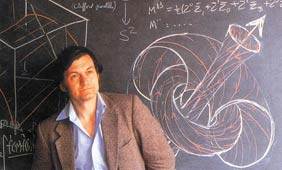 |
| Roger Penrose: "This number tells us how precise the Creator's aim must have been." |
The numbers defining the order and plan of the universe's equilibrium play a crucial role and exceed comprehension. They prove that the universe is by no means the product of a coincidence, and show us "how precise the Creator's aim must have been" as Penrose stated.
In fact in order to recognize that the universe is not a "product of coincidences" one does not really need any of these calculations at all. Simply by looking around himself, a person can easily perceive the fact of Creation in even the tiniest details of what he sees. How could a universe like this, perfect in its systems, the Sun, the Earth, people, houses, cars, trees, flowers, insects, and all the other things in it ever have come into existence as the result of atoms falling together by chance after an explosion? Every detail we peer at shows the evidence of Creation and Allah's supreme power. Only people who reflect can grasp these signs.
In the Creation of the heavens and earth, and the alternation of the night and day, and the ships which sail the seas to people's benefit, and the water which Allah sends down from the sky–by which He brings the earth to life when it was dead and scatters about in it creatures of every kind–and the varying direction of the winds, and the clouds subservient between heaven and earth, there are signs for people who use their intellect. (Surat al-Baqara:164)
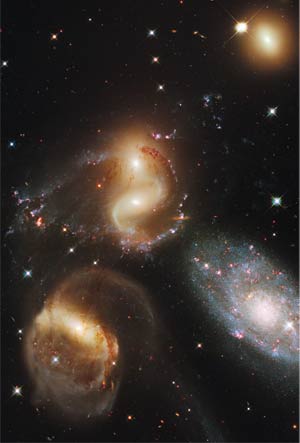 |
20th-century science has come up with categorical evidence that the universe was created by Allah. The anthropic principle that we mentioned before reveals every detail of a universe that has been created for mankind to live in and in which there is no place for chance.
The remarkable part is that the ones who discovered all this and came to the conclusion that the universe couldn't possibly have come into being by accident are the very same people who defend the philosophy of materialism. Scientists such as Paul Davies, Arno Penzias, Fred Hoyle and Roger Penrose are not pious men and they certainly had no intention of proving Allah's existence as they pursued their work. But they all reached the conclusion that–although some are unwillingly–universe is created by a superior power.
The American astronomer George Greenstein confesses this in his book The Symbiotic Universe:
How could this possibly have come to pass (that the laws of physics conform themselves to life)? …As we survey all the evidence, the thought insistently arises that some supernatural agency–or, rather Agency–must be involved. Is it possible that suddenly, without intending to, we have stumbled upon scientific proof of the existence of a Supreme Being? Was it God Who …. so providentially crafted the cosmos for our benefit?27
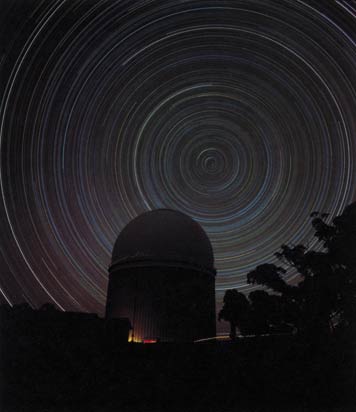 |
| These star trails were obtained by a special shoot of 9 hours. Almost all of the stars in this picture are circumpolar, which means they |
An atheist, Greenstein disregards the plain truth; nevertheless he cannot keep from wondering. Other, less prejudiced scientists on the other hand, readily admit that the universe must have been specially created for mankind to live in. The American astrophysicist Hugh Ross ends his article "Design and the Anthropic Principle" with these words:
An intelligent, transcendent Creator must have brought the universe into existence. An intelligent, transcendent Creator must have designed the universe. An intelligent, transcendent Creator must have designed planet Earth. An intelligent, transcendent Creator must have designed life.28
Thus science proves the reality of Creation. Certainly there is Allah and He has created everything around us–the seen and the unseen. He is the sole Creator of the extraordinary and outstanding equilibrium and order of the heavens and earth.
It has come such a pass that today, materialism has the flavor of a superstitious, unscientific system of belief. The American geneticist Robert Griffiths jokingly remarked "If we need an atheist for a debate, I go to the philosophy department. The physics department isn't much use."29
To sum up: Every physical law and every physical constant in this universe has been specifically created to enable human beings to exist and live. In his book The Cosmic Blueprint, Davies states this truth in the last paragraph, "The impression of Design is overwhelming."30
History of the Universe |
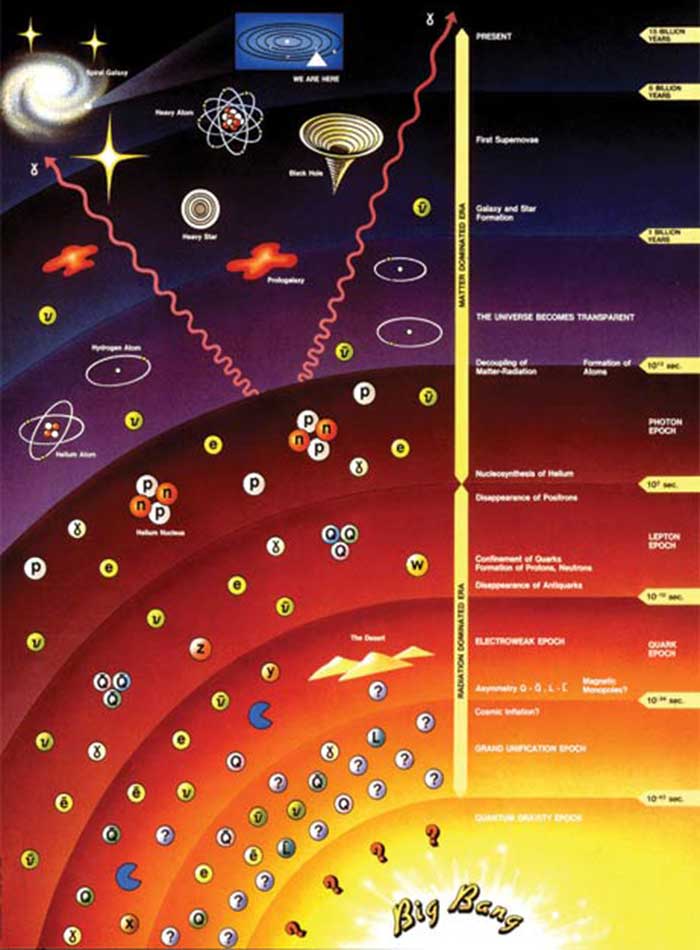 |
Doubtlessly, the order in the universe is evidence of Allah's power to establish. The precise balances and all the human beings and other creatures are among the evidence of Allah's supreme power and act of Creation. This result discovered by today's science is just a reworking of a truth revealed fourteen centuries ago in the Qur'an:
Your Lord is Allah, Who created the heavens and the earth in six days and then settled Himself firmly on the Throne. He covers the day with the night and, each pursuing the other urgently; and the Sun and Moon and stars are subservient to His command. Both Creation and command belong to Him. Blessed be Allah, the Lord of all worlds. (Surat al-A’raf: 54)
17. Paul Davies, Superforce: The Search for a Grand Unified Theory of Nature, 1984, p. 184 ![]()
18. Fred Hoyle, The Intelligent Universe, London, 1984, p. 184-185 ![]()
19. Paul Davies, Superforce: The Search for a Grand Unified Theory of Nature, 1984, p. 184 ![]()
20. Bilim ve Teknik (Science and Technics ) 201, p. 16 ![]()
21. Stephen Hawking, A Brief History Of Time, Bantam Press, London: 1988, p. 121-125 ![]()
22. Paul Davies. God and the New Physics. New York: Simon & Schuster, 1983, p. 189 ![]()
23. Michael Denton, Nature's Destiny: How the Laws of Biology Reveal Purpose in the Universe, The New York: The Free Press, 1998, p. 12-13 ![]()
24. Paul Davies. The Accidental Universe, Cambridge: Cambridge University Press, 1982, Foreword. ![]()
25. Hugh Ross, The Creator and the Cosmos, p. 122-23 ![]()
26. Roger Penrose, The Emperor's New Mind, 1989; Michael Denton, Nature's Destiny, The New York: The Free Press, 1998, p. 9 ![]()
27. George Greenstein, The Symbiotic Universe, p. 27 ![]()
28. Hugh Ross, "Design and the Anthropic Principle", Reasons To Believe, CA, 1988 ![]()
29. Hugh Ross, The Creator and the Cosmos, p. 123 ![]()
30. Paul Davies, The Cosmic Blueprint, London: Penguin Books, 1987, p. 203 ![]()